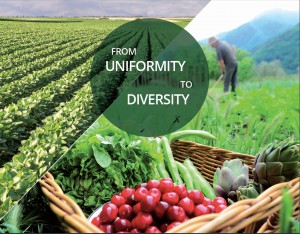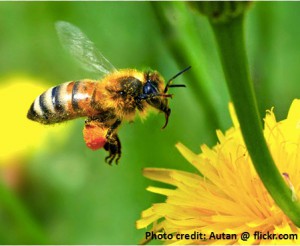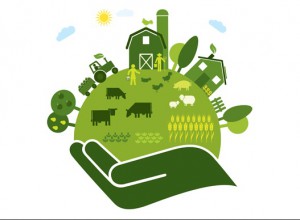Context
Several decades ago, even just years ago, it would have been unthinkable, for most, to argue for and sound convincing about leaving fossil fuels in the ground (or under the sea), to be replaced by sufficient renewable energy sources. Yet that concept is not so unthinkable now and there are serious, spreading efforts to do just that. The Guardian, in conjunction with Bill McKibben’s 350.org, launched a “Keep it in the ground,” and divestment campaign last year; more and more major, international financial and insurance organizations are warning about the deeply disturbing consequences if we do not leave fossil fuels stranded, unused. These same sources are warning of the serious financial risks from staying invested in fossil fuel companies. Renewables are expanding dramatically almost every year.
Perhaps it is time for a similar revolution against industrial agriculture and in favor of local, diversified farming.
Introduction: industrial agriculture vs agroecology
Most modern agriculture, at least in the economically developed world, is “industrial” in that it relies on specialization, like factories tend to do, and chemical inputs. It is also big and thrives on hundreds to thousands of animals per farm (Concentrated Animal Feeding Operations (CAFO), or monoculture where single or similar plant species are grown on large land holdings, with hundreds to thousands to tens of thousands of acres of farmland. It also uses tons and tons of fossil fuels, fertilizers, pesticides and antibiotics; and a few make tons and tons of money. The monoculture crops are distributed regionally, even globally, largely to big box-store retailers. Some of that money goes to fund research and development that reinforces the industrial form of agriculture. To a large extent, developing economies are trying to emulate this industrial system for agriculture.
In contrast, “agroecology” involves raising diversified crops without the heavy reliance on chemical inputs, with greater protection of biodiversity, and it can be done on small holdings without relying on specialized and large distribution and retail operations. In particular, the resilence of agroecology, where its fundamental operations depend less on a single crop and chemical inputs, allows it to adapt to changing climate conditions. Organic and subsistence farming share some common attributes of agroecology but the latter is a more fundamental transformation of agriculture.
One can point to evidence that family owned and operated, small local farms are around and working and surviving, and that organic farming has been growing. The question is whether those forms of farming, and even more diversified forms of agroecology can be replicated and expanded to reach a market-wide, even global, consumer base. Can agroecology feed “the world,” or does that question even make sense anymore?
A recent report, From Uniformity to Diversity: A paradigm shift from industrial agriculture to diversified agroecological systems, by iPES Food, an international panel of experts on sustainable food systems, attempts to answer these questions by comparing industrial and agroecological farming. Table 1, at 11 offers a succinct comparison between the two forms of agriculture.
Limitations of Industrial Agriculture
Modern industrial agriculture has contributed more food for more people, and advances in caloric intake and less famine, more varied diets and better food safety. But the price has been costly.
With the big comes some bad. Industrial agriculture depends on monocultures and chemical inputs that ruin soil, and pollute water from runoff of nitrates and phosphorous. It destroys biodiversity from large scale farming practices (e.g., destroying hedges to increase size of fields, with loss of habitat for a range of species). Populations of bees, flies, moths, bats and birds provide significant pollination and pest control but are being destroyed in part from heavy use of pesticides. Since 35% of global cultivated crops depend on pollination, industrialized agriculture is in effect destroying itself.
Globalisation and specialization allows farmers to outsource part of their production by relying on animal feed supplies from land use in other countries, freeing up more land at home for growing crops.
While yields from modern agriculture have helped feed many, evidence indicates that yields are leveling off, even declining. Between 1961 and 2008, in 24-39% of areas growing maize, rice, wheat and soybean, yields have failed to improve, stagnated or collapsed. Livestock is also at risk of lower productivity. The report indicates that various factors account for this lower productivity including land degradation, as well as loss of biodiversity and ecosystem services. Interestingly, the report notes that genetic uniformity has in the past made food products vulnerable to epidemics and biotic and abiotic stresses, citing the Great Irish Potato Famine in the 1840s. For livestock, we recently witnessed the spread of foot-and-mouth disease. Even now, highly specialised agriculture is subject to strains of diseases, as in Latin America where a soil fungus is threatening the banana industry that accounts for 80% of the world’s banana trade. Likewise, livestock breeds are dwindling with specialization and the genetic erosion puts stocks at risk from unpredictable risks to the environment from climate change.
On a global level, 7,000 plants have been used as food yet only three — rice, maize and wheat — provide more than 50% of the world’s plant-derived food energy intake.
This modern form of agriculture is contributing about 20 to 30% of global GHG emissions. In Ireland, methane from agriculture alone accounts for over 30% of the country’s GHGs.
About 70% of all water is withdrawn from aquifers, streams and lakes for use by agriculture. With the warming and drier conditions that are resulting from climate change, water will become an even more critical and scarce resource in the future, and many other users will be actively competing with agriculture for water. It is no exaggeration to say the oil wars will soon be replaced by water wars.
For all its contribution to wider distribution of food products, those foods contain more fat and higher carbohydrates. So obesity keeps expanding with over 1.9 billion people obese or overweight. And, critically, distribution is geared toward those who can pay the most and so does not reach poorer communities. As a result, amidst all the abundance of food in many places, there are still communities with high levels of malnutrition, with 795 million suffering from hunger and two billion from macronutrient deficiencies.
The Possibilities of Agroecology
What is most striking about agroecology is its flexibility and resilience in the face of environmental stress from climate change and disasters, and its capability to deliver food products from local sources to local places where food is desperately needed but being ignored by global distribution practices of industrial agriculture. Again in contrast, diversified crops from agroeology increase availability of key nutritional elements, especially legumes, fruits and vegetables, both at the farmhouse and in local markets.
Supporters of industrial agriculture talk about “feeding the world,” especially with a global population of 9 billion people expected by 2050, and that only specialised, monocultures can do that. The central logic is that increasing total production will solve the problem: more people simply need more food produced. The logic is fallacious.
First, studies of yields show that organic farming produces about 8% lower yields than conventional farming in developed countries, but 80% more yield in developing countries. And reflecting its resilience, organic farming produces higher yields in drought years. Organic farming is not a proxy for agroecology but it does share many of the same attributes and many of the studies so far have focused on comparing organic and conventional farming.
Second, as for those who need the food, industrial agriculture is not doing it now and likely cannot in the future. For instance, specialized food products are delivered in global trading systems to reach consumers, but this international trading scheme tends to reach the wealthy and bypass the poorer communities. As noted, 795 million people still suffered from hunger in 2015. As the report notes, “… there has been increasing recognition that hunger is fundamentally a distributional question tied to poverty, social exclusion and other factors affecting access to and utilization of food,” and that there is a “growing understanding that increases in productivity have to occur predominantly within developing countries if they are to have an impact on food and nutrition security, particularly among the poorest.” At 54.
In agroecology, the diversified food products and local control over inputs and distribution provide better services for those communities that most need the food. Using diverse outputs, some can be reused on the farm, e.g. fodder for animals. This farming system also focuses on shorter retail circuits with fewer intermediaries (farmers keep more value of their work), there are fewer input transactions, and more consumption by famers themselves. At 56.
The environmental benefits of agroecology far surpass industrial farming, from increases in biodiversity to improvement in soil health and water retention, and the possibility to restore degraded land. Improving soils and maintaining vegetative cover increase the critically important carbon sequestration.
In the final section of the report, the authors analyse how the transition can be effected from industrial agriculture to agroecology. The key recommendations, which are discussed in detail, are: develop new indicators for sustainable food systems; shift public support towards diversified agroecological production systems: support short circuits & alternative retail infrastructures; use public procurement to support local agroecological produce; strengthen movements that unify diverse constituencies around agroecology; mainstream agroecology and holistic food systems approaches into education and research agendas; develop food planning processes and ‘food policies’ at all levels.
Conclusion
Besides the agricultural-environmental dimensions to the agriculture sector, the report also analyses socio-economic factors that differentiate the two systems of agriculture. For example, a Dutch study of mixed farming systems found a 25% higher labour income per hectare, without increased environmental pollution, than in monoculture farming. And with reduced external inputs, like fertlisers, smallholders are not dependent on local retailers or moneylenders.
The report also analyses a series of factors that have allowed industrial agriculture to maintain its economic and political control over food production and distribution systems. Included are cheap fossil fuels; agricultural subsidies (including the EU CAP) that favor large, specialized farms; advances in transportation and refrigeration technology that supported an export-driven sector; development of processed foods; large retail outlets; and, water-drawing rights.
One overriding factor is the concentration of power in the hands of a few. Three companies controlled nearly 50% of the world’s commercial seed market in 2007; seven companies control almost all fertilizer supply; five companies share 68% of the world’s agrochemical market; and, four firms account for 97% of private research and development in the poultry sector.
Some would have us believe that the market is driving what happens in the agriculture sector. If the market is doing the driving, government policies and regulations, including subsidies, are directing the traffic. The hand of the government will be especially helpful in shaping the transition from industrial agriculture to agroecology, as it has in the transition from fossil fuels to renewable energies.
Sources
International Panel of Experts on Sustainable Food Systems, From Uniformity to Diversity: A paradigm shift from industrial agriculture to diversified agroecological systems (June 2016). www.ipes-food.org/images/Reports/UniformityToDiversity_FullReport.pdf
“Everything you wanted to ask about the Guardian’s climate change campaign,’ The Guardian (March 2015). www.theguardian.com/environment/2015/mar/16/everything-you-wanted-to-ask-about-the-guardians-climate-change-campaign
Cécile Barbière, “European parliament slams G7 food project in Africa,” The Guardian (8 June 2016). www.theguardian.com/global-development/2016/jun/08/european-parliament-slams-g7-food-project-in-africa
John Vidal, “A switch to ecological farming will benefit health and environment – report,” The Guardian (2 June 2016). www.theguardian.com/environment/2016/jun/02/a-switch-to-ecological-farming-will-benefit-health-and-environment-report



No comments yet, add your own below